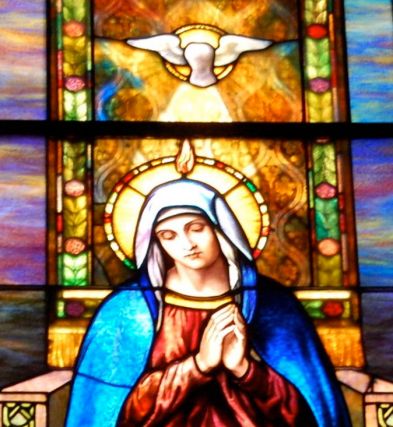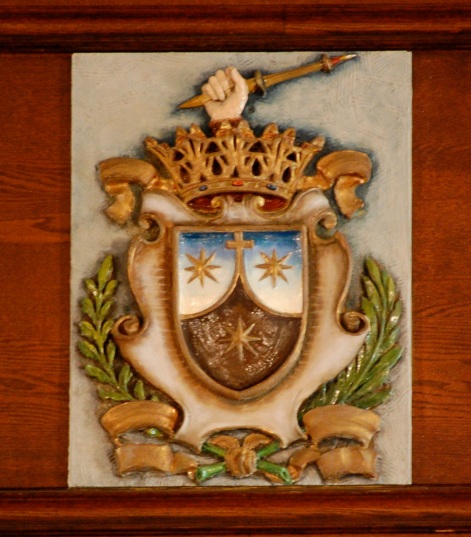The Philadelphia Carmelite Nuns may have left, but the Saints live on. I followed John of the Cross and Teresa of Jesus throughout the Carmelite Monastery asking for directions to reach the summit of Mt. Carmel. Here’s what I found…
 The Triumphal arch, with crucifix suspended, inspired by the crucifix of Fra Innocenzo de Palerno (1637) in the Church of San Damiano, Assisi. – Philadelphia Carmel
The Triumphal arch, with crucifix suspended, inspired by the crucifix of Fra Innocenzo de Palerno (1637) in the Church of San Damiano, Assisi. – Philadelphia Carmel
The origins of Triumphal arch comes from the Roman era when captives were led under an arch to symbolize their submission to the authority of Rome. Later centuries the liturgical procession through the triumphal arch symbolizes Christians as captives of Christ are lead to the Kingdom of Heaven. The sacred space of the sanctuary represents the Kingdom of Heaven.
 The sanctuary of the Holy Spirit Chapel, Mount Carmel.
The sanctuary of the Holy Spirit Chapel, Mount Carmel.
The two round medallions are Teresa of Jesus on the left and John of the Cross on the right.
 The Sanctuary of the Holy Spirit Chapel, Mount Carmel – Detail
The Sanctuary of the Holy Spirit Chapel, Mount Carmel – Detail
From left to right, Teresa of Jesus, the sanctuary doors with Cross, St. Elisha with hand raised to the Lamb of God. At top is the chariot with Elijah. The Holy Spirit is above Teresa in the form of a dove.
The Mosaic (Sanctuary)
The images of the mosaic express the reality of divine love in the charism of Carmel. It is love revealed by God in the Old Testament and fulfilled in the New, a love that en-kindles our hearts and transforms them. Ultimately this transformation enables one to enter, body and soul into full union with God. Horizontal and spatial concepts of the mosaic echo passages of time in the Old and New Testament history of the Carmelite order.
Images and symbols include the following:
Fire and Water
Fire increased its own virtue in the water – Wisdom 19:20
These lamps of fire are living waters of the spirit…although it is fire, it is also water. – St. John of the Cross, The Living Flame of Love Stanza 3, #8
Oh, God help me, what marvels there are in this greater en-kindling of fire by water. The water does not impede the fire though it’s the fire’s contrary, but rather makes its fire increase! St. Teresa of Jesus, The Way of Perfection 19:3
Water
Water symbolizes cleansing as in the river Jordan; baptism, blessing, grace, prayer and contemplation. – St. Teresa of Jesus, Life 11:7
Fire
Fire symbolizes divine love. – St John of the Cross, Spiritual Canticle 39:14, St. Teresa of Jesus Life 30:20
Chariot of Fire
in Christian art, St. Elijah carried into heaven in a chariot of fire is a symbol of Christ’s Ascension. In the Dialogue of St. Catherine of Siena, Christ himself is referred to by the Father as a fiery chariot.
St. Elijah (c 870 BC) (in chariot)
Elijah the Prophet is called the founder of the Carmelite ideal. There are two accounts of him being taken up to heaven in a fiery chariot 2 Kings 2:1-12 and Sirach 48:9. His feast is celebrated by the Carmelite Order on July 20.
The Holy Spirit (Dove)
The Holy Spirit is the third Person of the Blessed Trinity, the Sanctifier, the living Flame of Love. – Romans 5:5
St. Teresa of Jesus
St.Teresa of Jesus (1515-1582), the foundress of the reformed Carmel (Discalced Carmelites) is portrayed in Eucharistic Adoration. In her spiritual writings one finds frequent images of fire and water.
The Lamb of God and the Eucharist
Fulfillment is found in Christ, the Alpha and Omega, the sacrificial lamb of god, who gave himself for the life of the world. His sacrifice is perpetuated in the Eucharist. From this divine reality the graces symbolized by the fire and the water are sought and obtained. Mt. 26;26-29; 1 John 5:6-8; Rev:5:6-14
St. Elisha (c. 840 BC) was the first disciple of St. Elijah. He was the leader of the prophets on Mt. Carmel. The Carmelite order celebrates his memory on June 14.
Between Elisha and Teresa of Jesus, with the arrow pointing up, are the sanctuary doors. A schematic of the Sanctuary Doors is below.

The symbols that are employed on these bronze doors show St. Teresa’s image of the Interior Castle. They are:
Door
“The door of entry to this castle is prayer and reflection.” – St. Teresa of Jesus, Interior Castle I:i,#7
Castle
The castle is the image of the soul: We consider our soul to be like a castle made entirely out of a diamond or of a very clear crystal in which there are many rooms, just as in heaven there are many dwelling places. – St. Teresa of Jesus, Interior Castle
The soul of the just person is nothing else than a paradise where the Lord says He finds His delight. I do not find anything comparable to the magnificent beauty of a soul and its marvelous capacity. – St. Teresa of Jesus, Interior Castle I:i, #1
Triangle
The triangle is the symbol of the Most Holy Trinity dwelling in the center of the soul.
Cross
The Cross is the symbol of the Paschal Mystery of Christ’s passion, Death and Resurrection.
Blood and Water
Blood and water flowed out of our Redeemer on the Cross. The Fathers and Doctors of the Church interpret this to mean that from the pierced Heart of the Son, God the Father pours out through the Holy Spirit, the saving graces of the Church’s Sacraments.
“One of the soldiers pierced His side with a lance and immediately there came out blood and water. – John 19:37
Jesus Christ who came by water and blood, not with water only, but with water and blood. – 1 John 5:6
He loves us and has washed away his own sins in His own Blood… Rev1:5
Then the angel showed me the river of life, rising from the throne of God and of the Lamb and flowing crystal clear down the middle of the city street. Rev 22:1-2
Center Room of the Castle
The castle has many dwelling places. Located at the center, is the abode of the most Blessed Trinity: the Father, the Son, and the Holy Spirit. It is here, in intimacy, that sweet exchanges of love occur between God and the soul. Mysteries of the Holy Trinity are made manifest and the soul comes to understand the Gospel passage:
If anyone loves me he will keep my word,
and my Father will love him,
and we shall come to him
and make out home with him. – John 14:23
Shell
The shell is a symbol of Baptism, the sacrament of initiation to the divine life.

Blessed Virgin Mary, dwelling with the Holy Trinity in the most profound union, supreme above all creatures, beloved Daughter of the Father, mother of the Son, Spouse of the Holy Spirit Mediatrix of all Graces.
Discalced Carmelite Order (OCD) Coat of Arms plaque.
Located on balcony front, near organ of the Holy Spirit Chapel, Philadelphia Carmel.
Seal of Mount Carmel
In the center of the seal is Mount Carmel, cradle of the Carmelite Order, and the star in the mountain refers to the Our Lady of Mount Carmel. The two stars above are the prophets Elijah and Elisha.
Mount Carmel is the Carmelite’s place of origin located in modern day Haifa, Israel. In the 9th century BC the prophet Elijah lived there and had a profound experience of God. In that same place in the early 12th century some hermits, inspired by the memory of Elijah, gathered there, with a desire “to live a life of allegiance to Jesus Christ” (Rule of St. Albert).


